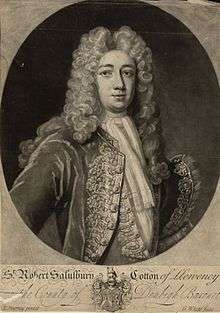Sir Robert Salusbury Cotton, 5th Baronet
Sir Robert Salusbury Cotton, 5th Baronet (c. 1739 – 24 August 1809) was an English politician. He was Member of Parliament (MP) for Cheshire from 1780 to 1796.

Life
Son of Sir Lynch Cotton, he was one of the founders of the Tarporley Hunt Club in 1762.[1] In 1774 he was elected a fellow of the Royal Society.[2]
Educated at Cambridge, soon after the birth of his second son he moved from the old Salusbury seat at Lleweni Hall to Combermere Abbey, the traditional seat of the heir apparent to the Baronetcy. The subsequent leasing of the family's former estate to the Hon Thomas FitzMaurice, a brother of Lord Shelburne's, was necessitated by the profligacy of his uncle, Sir Thomas. Nevertheless, Sir Robert kept a large hunting establishment and was known as a generous host.[3]
Family
He married Frances Stapleton, daughter and co-heiress of James Russel-Stapleton Esq in 1767. In 1774 they were visited at Llewenli Hall by Sir Robert's cousin, Hester Thrale, who was accompanied by the noted writer, Samuel Johnson; Frances "found Johnson, despite his rudeness, at times delightful, having a manner peculiar to himself in relating anecdotes that could not fail to attract old and young. Her impression was that Mrs. Thrale was very vexatious in wishing to engross all his attention, which annoyed him much". The Cottons later broke off relations with Hester following her 1784 marriage to an Italian music teacher.[4]
Issue
Sir Robert and his wife had the following children:[5]
- Robert-Salusbury (born 11 September 1768), died without issue
- Stapleton (1773–1865), 6th baronet, elevated to the peerage as a Viscount and Baron Combermere
- William (died 16 June 1853), took holy orders
- Lynch, colonel in the army; died in the East Indies in 1799
- Frances (1 December 1769 – 26 November 1818), married Robert Needham, 11th Viscount Kilmorey (1746–1818) on 10 January 1792
- Penelope (31 December 1770 – 1786)
- Hester-Maria (died 20 March 1845)
- Sophia (died 24 May 1838), married Sir H. M. Mainwaring, Bart, of Over Peover, Chester
References
- ↑ Egerton-Warburton RE. "A short account of the Tarporley Hunt Club, from its foundation in 1762 to the year 1869". In Hunting Songs (Henry Young & Sons; 1912) (accessed 11 May 2010)
- ↑ "Library and archive Catalogue". Royal Society. Retrieved 2012-03-18.
- ↑ Stapleton Cotton, Stapleton Cotton & Knollys 1866, p. 18.
- ↑ Stapleton Cotton, Stapleton Cotton & Knollys 1866, p. 22.
- ↑ Burke, Bernard (1869). A Genealogical and Heraldic Dictionary of the Peerage and Baronetage of the British Empire. London: Harrison. p. 254.
- Bibliography
- Stapleton Cotton, Mary Woolley; Stapleton Cotton, Stapleton; Knollys, William Wallingford (1866). Memoirs and Correspondence of Field-marshal Viscount Combermere, from his family papers, by Mary Viscountess Combermere and W.W. Knollys.
| Parliament of Great Britain | ||
|---|---|---|
| Preceded by John Crewe and Samuel Egerton |
Member of Parliament for Cheshire with John Crewe 1780–1796 |
Succeeded by John Crewe and Thomas Cholmondeley |
| Baronetage of England | ||
| Preceded by Lynch Salusbury Cotton |
Baronet (of Combermere ) 1775–1809 |
Succeeded by Stapleton Cotton |